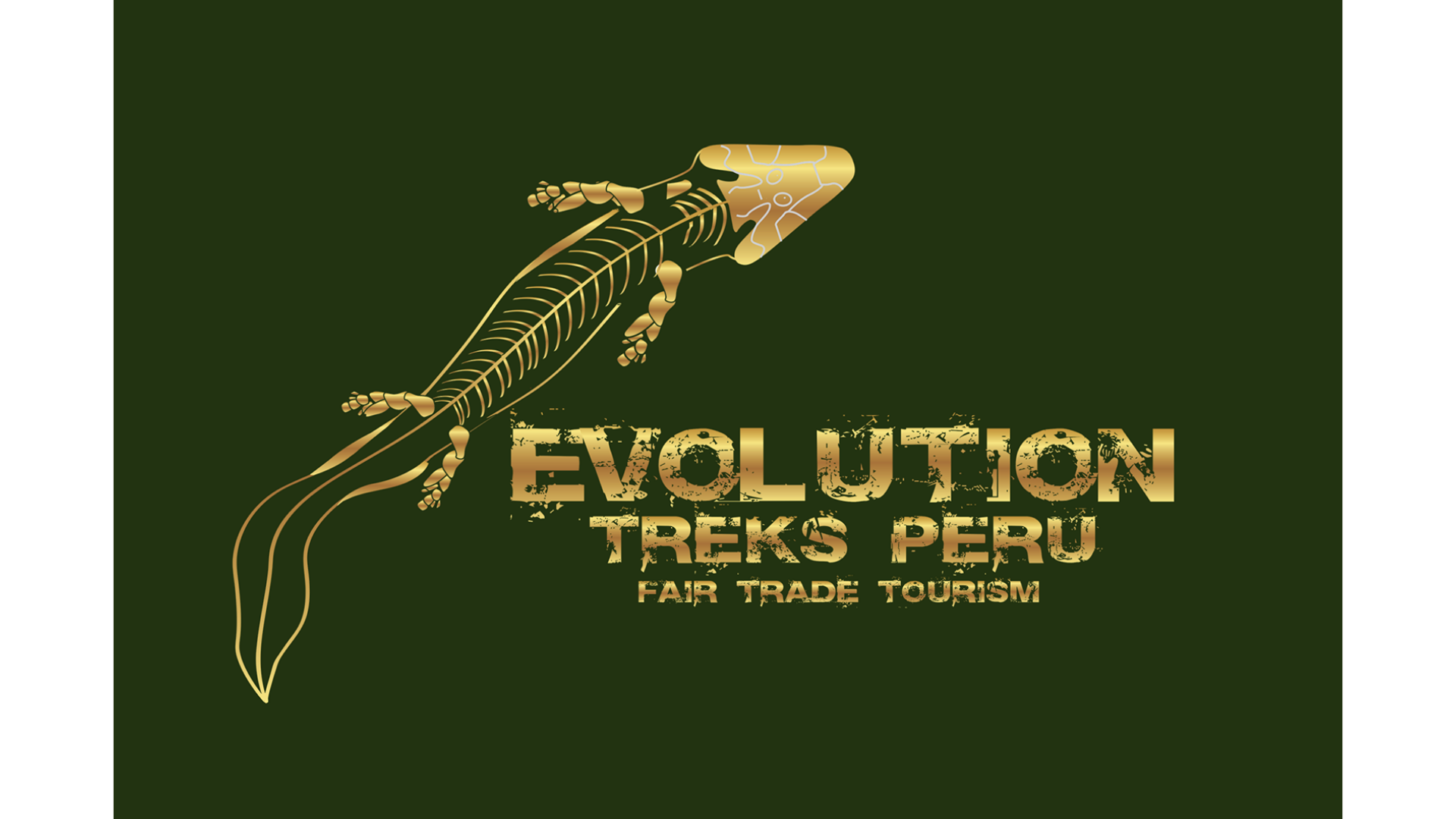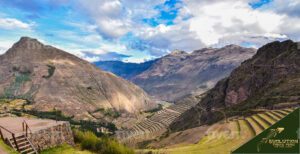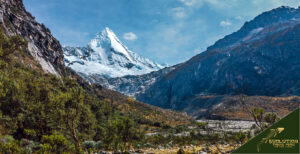Wiñay Wayna, meaning “Forever Young” in Quechua. It is an ancient Inca archaeological site that sits on a steep mountainside overlooking the Urubamba River and is surrounded by the awe-inspiring Andean landscape. Wiñay Wayna stands as a testament to the impressive architectural skills and ingenuity of the Inca civilization.
Although its exact origins are uncertain. It is believed to have been built during the late 15th or early 16th century. Around the same time as Machu Picchu, a renowned city.
As with other Inca sites, Wiñay Wayna was constructed without mortar using meticulously carved stones that fit perfectly together. It was part of the Inca Empire, which was the largest pre-Columbian civilization in the Americas. The Incas were highly skilled in engineering, agriculture, and administration and established an extensive network of roads and cities throughout their empire. These cities served various functions including religious ceremonies administration purposes as well as residential needs.
Wiñay Wayna likely had multiple purposes as well. It functioned as a religious center with ritual baths and terraces designated for ceremonial activities.
Moreover. It provided agricultural support with terraces carved into the mountainside specifically for farming purposes. Additionally.
It is believed that this site played a role in accommodating and assisting travelers along the Inca Trail. As for its abandonment over time, specifics remain unknown.
However, it is believed that when Spanish conquistadors arrived in the early 16th century – marking the decline of the Inca Empire – numerous Inca sites, including Wiñay Wayna, were forsaken. To this day though. Wiñay Wayna continues to captivate tourists who embark on hikes along the revered Inca Trail.
The site offers a remarkable glimpse into both architectural mastery and agricultural achievements accomplished by these ancient people. Tourists have the opportunity to explore and learn about the rich history, cultural practices, and significance of Wiñay Wayna through various guided tours. Situated amidst mesmerizing surroundings of lush vegetation cascading waterfalls, and towering mountains Wiñay Wayna holds an awe-inspiring geographical location.
Its terraces and structures seamlessly blend with the natural landscape showcasing the Incas’ deep respect for their environment. Such is its prominence in the tourism industry that it significantly contributes to Peru’s economy. Tourists flock to this remarkable site to explore Peru’s rich archaeological heritage, which includes iconic destinations like Machu Picchu and Wiñay Wayna. The revenue generated by tourism not only boosts the economy but also creates employment opportunities and supports local businesses.
Making it a crucial sector for Peru’s economic growth. Approximately 20 structures can be found at Wiñay Wayna, including residential buildings, ceremonial platforms, agricultural terraces, and a series of fountains and baths. This well-planned layout reflects the meticulous urban planning and engineering skills of the Incas. The number of tourists visiting Wiñay Wayna varies throughout the year.
Due to its proximity to Machu Picchu and its inclusion on the Inca Trail, it receives a significant influx of visitors. However. Restrictions are imposed on hiking trails and daily visitor limits at Wiñay Wayna in order to preserve and protect this precious site. These measures play a vital role in minimizing the impact of tourism while ensuring its sustainability for future generations to appreciate and learn from.
What is the Wiñay Wayna History?
Winay Wayna or Wiñay Wayna’s history is deeply entangled with that of the Inca Empire (AD1438–1471 to AD1533-34) when its territorial reach extended over much of South America’s western side before its leaders’ defeat by Spanish Conquistadors led by Francisco Pizarro. This site dates back to what many experts posit could be AD1529 –1550 based on its similarities with other sites within this timeline due to architecturally similar designs present at those locations; organic materials found there underwent radiocarbon dating analysis, subsequently reinforcing such claims-all proposals anthropology experts still need further work on. It is believed that this place served in two capacities: firstly as an agricultural center and secondly as a religious center possibly used for pilgrimage purposes or resting grounds for pilgrims making their way towards Machu Picchu too. Upon conquest by Spanish colonizers’ victory against the Incans’, this location was deserted, eventually proving so per monumental silence extending back then up until late in the 19th century when Hiram Bingham, one American explorer charting these areas sought out revealing hidden beauty- and as he later stated upon discovery- it was “the most beautiful site in the whole valley.” Since then, Winay Wayna has become a favorite destination for tourists and hikers. Nowadays, visitors to Winay Wayna enjoy an up-close view of Incan architectural prowess, showcasing their engineering skills and a glimpse of how critical religion was to this empire.
What does Wiñay Wayna Mean?
Winay Wayna is a Quechua term that means “forever young” or “eternally young” in English. The name comes from a type of orchid found in the area, which is said to resemble a young woman. The orchid was also associated with a mythological story among the Incas about a young woman who was transformed into a flower and remains eternally youthful.
The name Winay Wayna was given to an Inca archaeological site located along the Inca Trail in Peru, near Machu Picchu, which includes several terraces, buildings, and water features. The site is believed to have been constructed by the Incas during the 15th century and was likely used as a stopping point for travelers on the Inca Trail and a religious site for the Incas.
How is the Architecture of Wiñay Wayna?
The architecture of Winay Wayna is typical of the Inca civilization,wiithout lacking in splendor, the ruins of Wiñay Wayna proudly display themselves in two clusters—the upper and lower houses—bindingly connected by an extensive and perilous staircase embellished with resplendent fountain structures favorably known as “baths.” Conspicuously positioned toward the north of this enchanting house-staircase complex lies an extensive area believed to have once sustained agricultural terraces—a testament to sustainable engineering practices passed down through generations. Artistic mastery finds fruition within its walls; while some stonework exhibits variability in quality, a marvelous portion showcases unparalleled craftsmanship and meticulous stone assembly—a radiant exhibition unique unto itself. A strategic perch atop Wiñay Wayna gives rise not only to opulent vistas but also cements its profound importance within the Urubamba drainage area as a sentinel overlooking an ancient access road integral to Inca occupation days long gone by. By each measure and beyond any shadow of a doubt, Wiñay Wayna reverberates with echoes from past centuries—iconic evidence celebrating the Inca civilization’s trailblazing architectural acumen and their unswerving penchant for integrating human settlements with the very heartbeat of nature’s landscape.
What are some notable artifacts discovered at Wiñay Wayna?
As an archaeological site, Winay Wayna has yielded several artifacts that shed light on the culture and practices of the Inca people who built and used the site. Some of the artifacts that have been discovered at Winay Wayna include the following:
- Ceramics: Archaeologists have found various ceramic objects at Winay Wayna, including plates, bowls, and jars. These objects were likely used for storing and preparing food, as well as for ceremonial purposes.
- Textiles: The Inca were known for their textile production, and many textile fragments have been found at Winay Wayna. These fragments include pieces of clothing and decorative textiles that were likely used in ceremonies.
- Tools: Various tools have been discovered at the site, including stone hammers and chisels that were likely used in constructing the site’s buildings and terraces.
- Metal objects: Although the Inca did not have a written language, they were skilled metalworkers, and many metal objects have been found at Winay Wayna. These include objects such as knives, needles, and jewelry.
- Bones: Archaeologists have also found animal bones at the site, which provide insight into the diet of the people who lived and worked at Winay Wayna. The bones of llamas, alpacas, and guinea pigs have all been found, suggesting that these animals were raised for food.
These artifacts, along with others discovered at Winay Wayna, provide valuable information about the Inca culture and their way of life.
When did Wiñay Wayna get its name?
1942, it was Dr. Julio C. Tello—an esteemed Peruvian archaeologist—graciously bestowed upon these ruins the appellation Wiñay Wayna—the embodiment of “Eternal Youth. The name “Winay Wayna” means “forever young” or “eternally young” in the Quechua language. The name “Winay Wayna” is derived from a type of orchid that grows in the area, which is said to resemble a young woman. The orchid was also associated with a mythological story among the Incas about a young woman who was transformed into a flower and remains eternally youthful.
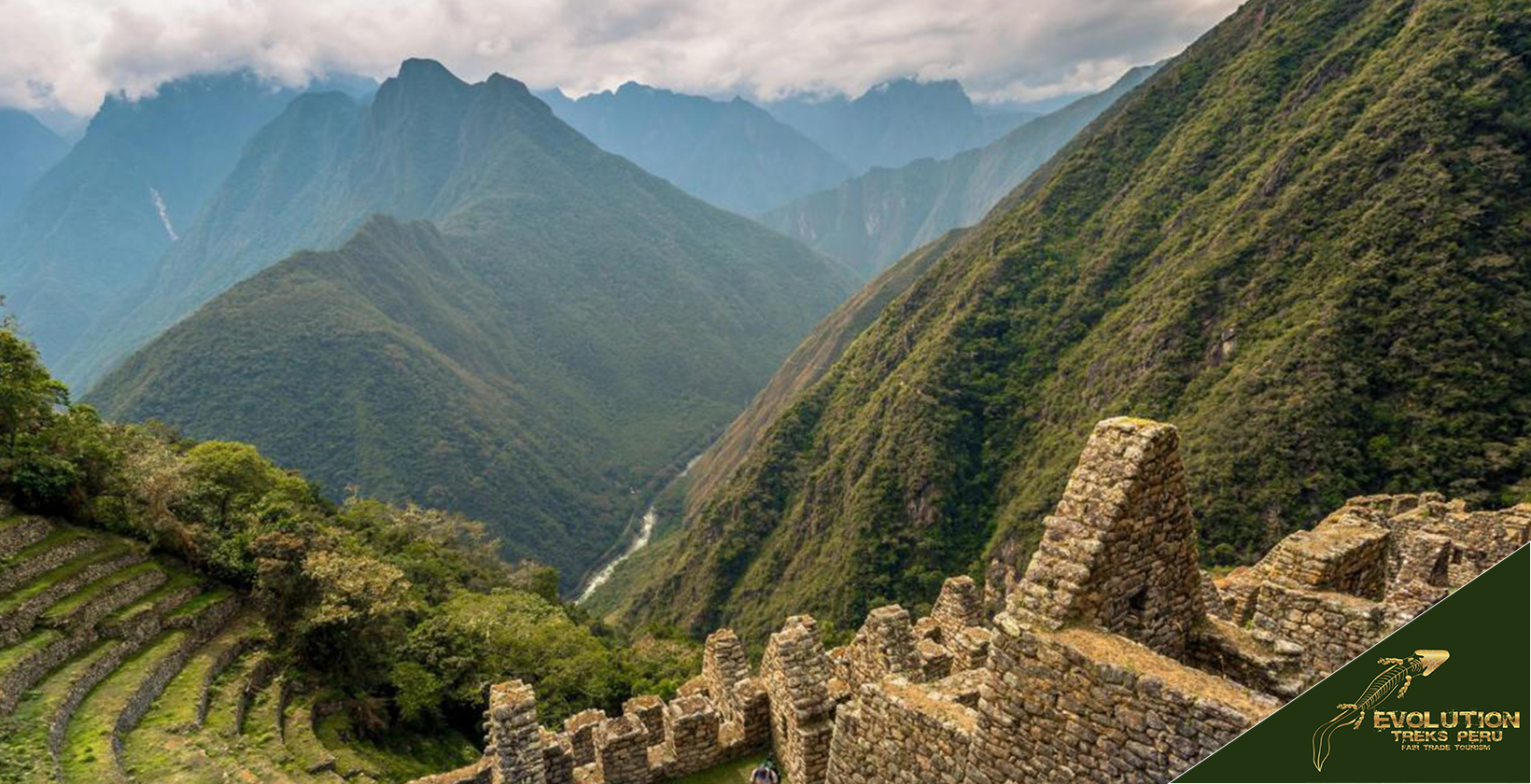
Which Civilization used Wiñay Wayna for what?
The Inca civilization is attributed to having built Winay Wayna. This pre-Columbian civilization flourished in the Andean region of South America from the 13th to the 16th centuries. The site is located along the Inca Trail in Peru, near Machu Picchu.
The Incas likely used Wiñay Wayna as a stopping point for travelers on the Inca Trail and a religious and ceremonial site. The site includes several terraces, buildings, and water features constructed from stone, and it is an impressive example of Inca engineering and construction.
The buildings at Wiñay Wayna were likely used as living quarters for Inca priests and their attendants, while the terraces were used for agriculture, such as growing crops like maize and potatoes. The water features were likely used for irrigation and ceremonial purposes.
After the Spanish conquest of the Inca Empire in the 16th century, Wiñay Wayna was abandoned and eventually forgotten. The site was rediscovered in the early 20th century by archaeologists, and it has since become a popular destination for hikers on the Inca Trail and a valuable archaeological site for studying the culture and practices of the Inca civilization.
What are the theories about the origin of the Wiñay Wayna?
The true origin of Winay Wayna remains a mystery. Leaving room for various theories regarding its construction and purpose. Here we will discuss some of the most commonly debated ideas:
- One hypothesis suggests that Winay Wayna was established as a sacred site by the Inca civilization intended for ceremonial rituals and offerings to their deities. The presence of water features at the location supports this theory as they likely held symbolic and religious significance for the Inca.
- Alternatively, another theory proposes that Winay Wayna primarily served as an agricultural site dedicated to cultivating crops such as maize and potatoes. The terraced structures surrounding the area would have provided ideal conditions for agricultural activities. Additionally, its convenient placement along the Inca Trail would have made it suitable for farming and storing these essential resources. Some experts argue that Winay Wayna was an administrative center within the Inca Empire. It is believed that high-ranking officials oversaw the management of nearby resources and regulated the transportation of goods along the Inca Trail. The terraced structures may have served as storage facilities or distribution points.
- A different perspective suggests that Winay Wayna was a military outpost strategically positioned along the Inca Trail to defend against potential adversaries.
Its location on a steep hillside would have posed challenges to attackers attempting to breach its defenses.
Throughout history, Winay Wayna served multiple purposes fulfilling diverse roles depending on societal needs. While we may only partially understand its precise meaning. Visitors today still marvel at its remarkable engineering and architectural features, which continue to captivate our imagination and curiosity.
What are the myths about Wiñay Wayna?
Winay Wayna is surrounded by various myths and legends associated with its name. Meaning “forever young” in the Quechua language. These narratives reflect the region’s rich cultural heritage and contribute to its mystical ambiance.
- One well-known myth is that of the Orchid Maiden, where the gods transformed a beautiful young woman named Wiñay Wayna into an orchid to preserve her eternal youth and beauty. It is said that a flower resembling this maiden can be found near the archaeological site.
- Another captivating tale involves the myth of the Eternal Spring. According to this legend, there exists a spring at Winay Wayna that never dries up, even during extended periods of drought. The spring is regarded as a divine gift from the gods and serves as a symbolic representation of their power and benevolence.
- Furthermore, there is a myth pertaining to the Inca Trail that passes through Winay Wayna. This trail was believed to be created by Wiracocha, a god who traversed mountains and valleys across the Andes to bestow civilization upon humanity. This sacred route leads travelers directly to the heart of the Inca Empire.
While these myths may be intriguing stories passed down through generations, they also have significant cultural value as they keep Inca traditions and folklore within the Andean region alive. Moreover. They contribute immensely to Winay Waynas’ allure. Creating an otherworldly atmosphere for visitors and hikers who embark on their journey along the legendary Inca trail.
Trail.
Is Wiñay Wayna Important for Peru’s History?
Perched gracefully amidst Peru’s vibrant history and priceless cultural legacy stands Wiñay Wayna – an embodiment treasured for ages to come. A testament to human ingenuity attributed to the famed Incas brought breathtaking insights into their profound storylines at this archaeological oasis. Adorned skillfully with intricate terraced structures, stone towers, and serene water features, Wiñay Wayna radiates a powerful testament to the Inca’s remarkable ability to harmoniously integrate with nature while yielding marvelously utilitarian and aesthetically captivating architectural triumphs.
Nestled charmingly along the prestigious Inca Trail, Wiñay Wayna claims its historical weight as integral to a vast network interlinking diverse regions within this formidable empire. Serving as a conduit facilitating seamless exchange – be it people, trade, or knowledge – the Inca Trail formed the lifeblood vital for political governance and economic vitality across the empire’s lands. Presently, cherished by travelers venturing to Peru’s enchanting tapestry lies Wiñay Wayna – an iconic ruin etched amidst the revered Inca Trail offering awe-inspiring cultural and historical significance intertwined seamlessly with picturesque natural beauty – truly affirming its indelible place within Peru’s cultural heritage while paying homage to the radiant legacy forged by the ingenious Incas.
Where is Wiñay Wayna Located?
Located in Peru near the renowned ancient city of Machu Picchu, Wiñay Wayna is an archaeological site. Positioned along the famous Inca Trail. This site is found in the Urubamba province of the Cusco region at an elevation of approximately 8,900 feet (2,700 meters) above sea level. Situated on a steep hillside overlooking the Urubamba River. It offers remarkable views of the surrounding mountains and valleys. To reach this site. Visitors must hike the Inca Trail, which can be accessed from various points in Perus’ Sacred Valley region.
Obtaining a permit in advance is necessary for this challenging yet unforgettable journey that allows travelers to engage with Andean natural and cultural beauty deeply.
What are the coordinates of Wiñay Wayna?
The coordinates for Wiñay Wayna, an archaeological site on the Inca Trail near Machu Picchu in Perus’ Cusco region. Are around 13.1586° S, 72.5462° W. It is worth noting that because of the sites’ location and terrain, GPS coordinates may not be wholly accurate or reliable.
Therefore. It is essential to refer to official maps and guides when planning a visit to the area.
How did Wiñay Wayna become well-known?
Archaeologists began delving into an intensive study of multiple archaeological sites linked closely with the Inca Trail during the early 20th century – one being none other than Wiñay Wayna itself.Paul Fejos, and the renowned Peruvian Archeologist Julio C Tello, were the ones who explored these sites in 1940 and after. Julio C Tello is attributed with discovering this wonderful piece of incan architecture.
As word spread about their groundbreaking research, global curiosity surrounding this site and its association with the Inca Trail grew tremendously. Consequently, adventurers and globetrotters from distant lands flocked eagerly in pursuit of exploring these unique surroundings firsthand. Today Wiñay Wayna proudly stands tall as an exceptional testimony to both natural beauty and architectural genius possessed by ancient Incas along their trail toward Machu Picchu.
It has become an indelible highlight for anyone embarking on hiking expeditions to this revered destination. Its breathtaking landscapes, ingenious engineering marvels, and profound cultural heritage continually entice and captivate patrons from every corner of the earth, elevating it to the ranks of Perus’ most iconic archaeological sites.
What are the things to see in Wiñay Wayna?
Wiñay Wayna is an archaeological site that is both fascinating and impressive. It offers a plethora of exciting things to see and explore. Here are some of the highlights:
- The terraced structures at Wiñay Wayna are genuinely remarkable. They are among the most well-preserved terraces found in any Inca site. These terraces served an important agricultural function. Preventing erosion. Moreover, they are built into the hillside in a way that is not only functional but also aesthetically pleasing.
- The stone buildings at Wiñay Wayna were likely used as living quarters for priests and their attendants. These buildings showcase trapezoidal doorways and windows and lintels made of massive stone blocks weighing several tons. Water features play a significant role at this site.
- There are fountains and channels that were utilized for both irrigation purposes and ceremonial rituals. The construction of these water features is magnificent, reflecting the Incas’ deep reverence for water as a sacred element. In addition to its man-made wonders.
- Wiñay Wayna boasts a variety of orchids. The area surrounding the site is known for its vibrant orchid population, which adds to the natural beauty of the surroundings and provides a striking contrast against the stone structures.
- Situated on a picturesque hillside, Wiñay Wayna offers breathtaking views of the surrounding mountains and valleys. Its location along the Inca Trail grants visitors a unique perspective on both the landscape and the trail itself.
Overall Wiñay Wayna provides valuable insights into Inca engineering, architectural prowess, cultural practices, and religious beliefs during that time period. It is truly a must-see destination for anyone interested in Perus’ rich history and culture.
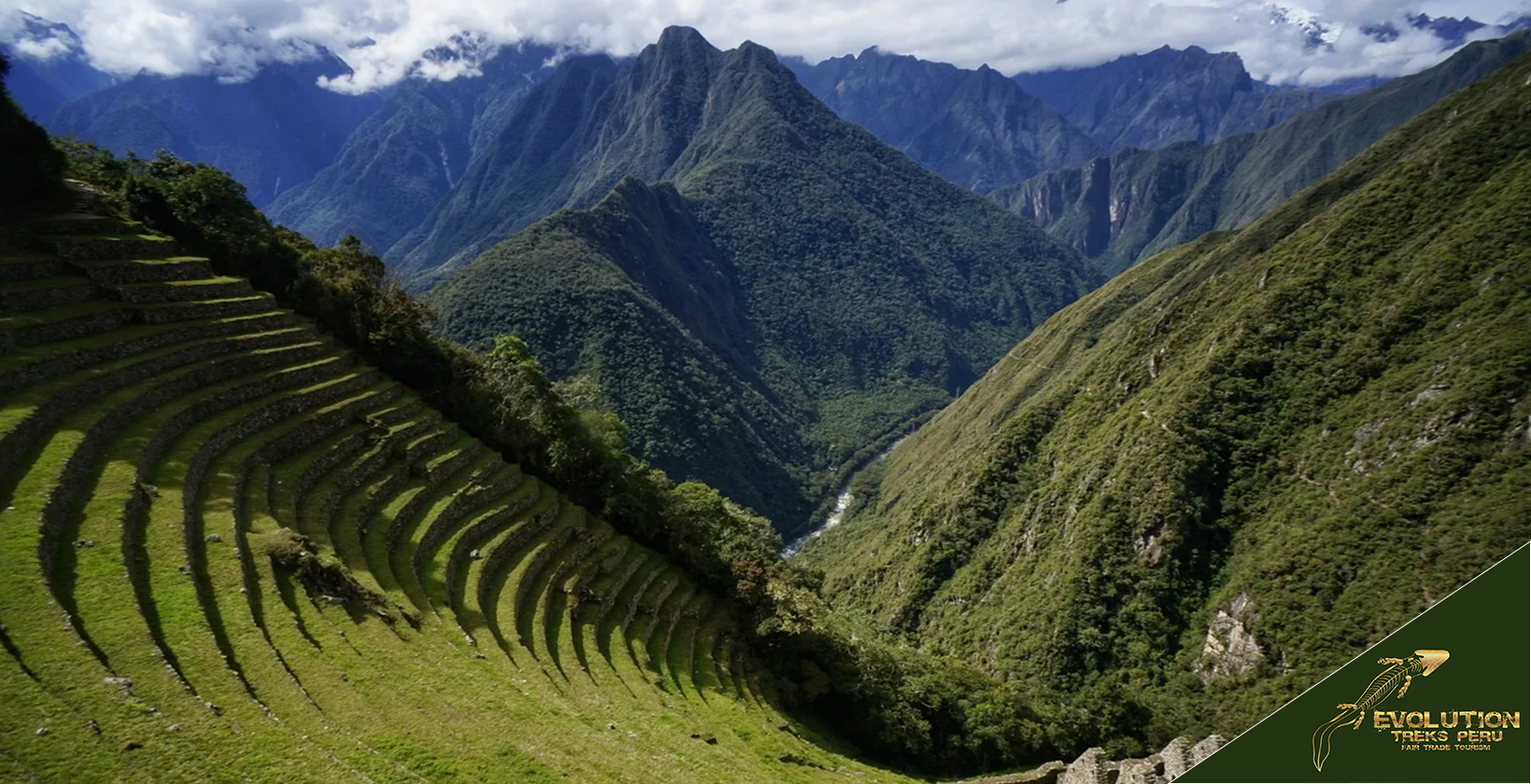
How is the Map of Wiñay Wayna Layout?
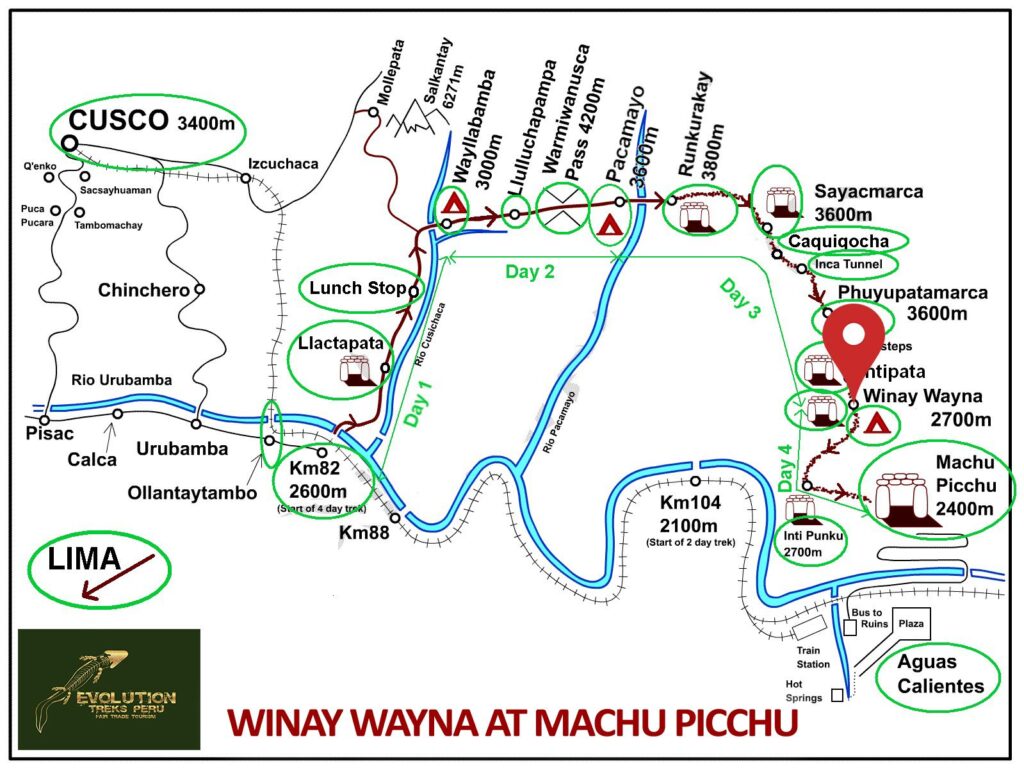
How is the Geography of Wiñay Wayna?
Wiñay Wayna, situated in the scenic Cusco region of the Andes Mountains in Peru captivates visitors with its breathtaking geography.
- The site is perched on steep hillsides that offer commanding views of the majestic mountains and valleys. Careful measures have been taken to construct terraced structures that prevent erosion and manage water runoff gracefully.
- Immersed in dense forests typical of the Andean region. Wiñay Wayna provides a sanctuary for a diverse range of plant and animal species. Visitors can encounter orchids, hummingbirds, and even spectacled bears while exploring this magical place.
- Water features at the site, including fountains and channels ingeniously designed to collect water from nearby streams and springs. Create a serene ambiance. Managing water runoff efficiently adds to both the functionality and tranquility experienced in this remarkable location. The climate around Wiñay Wayna maintains a cool and dry atmosphere. Daytime temperatures range between 50°F (10°C) to 70°F (21°C) providing pleasant conditions for exploration. While December to March sees increased rainfall making it advisable to plan accordingly drier weather prevails throughout most of the year.
All in all, Wiñay Wayna exemplifies the natural beauty and diversity abundant in the Andean region. Its elevated hillside position alongside mesmerizing water features and awe-inspiring vistas make it an immensely popular destination for tourists and avid hikers along the Inca Trail.
What is the Geological Profile of Wiñay Wayna?
Wiñay Waynas’ geological profile showcases the remarkable rock formations and geological features of the Andes Mountains. This area is composed of intricate tectonic plates, sedimentary layers, and volcanic activity. Below is a list of some of the noteworthy geological features of Wiñay Wayna:
- Rock formations: The site sits upon a steep hillside adorned with an array of rock formations such as granite, limestone, and sandstone. These formations have been shaped by various geological processes over an immense span of time including tectonic movements, erosion, and volcanic activity. Fault lines: Wiñay Waynas’s vicinity is marked by several active fault lines that contribute to its rugged terrain and unique rock formations. These fault lines also give rise to recurrent earthquakes and volcanic activity in the region.
- Volcanic activity: The Andes Mountains have gained renown for their volcanic activity boasting both active and dormant volcanoes in this area. Such volcanic activity has significantly influenced the landscape by creating steep hillsides, rocky outcroppings, and mineral-rich soil.
- Soil composition: The soil found here boasts a rich composition derived from the minerals deposited through volcanic eruptions. This fertile soil has played a pivotal role in agriculture and has greatly contributed to the development of the Inca civilization.
- Hydrology: Wiñay Wayna is characterized by an assortment of water features including springs, fountains, and channels. These water features are a result of the hydrological cycle driven by the region’s steep topography and abundant rainfall during the wet season. In summary, Wiñay Waynas’ geological profile is emblematic of the intricate and diverse geology found within the Andes Mountains. Over millions of years, these geological features have molded both the landscape and environment of this region.
Furthermore, they have played a crucial role in shaping the Inca civilization as well as maintaining its natural beauty today The Inca Trail is a popular destination for tourists and hikers alike.
What are the Hiking Routes in Wiñay Wayna?
There are only two hiking routes that traverse Wiñay Wayna, which is located along the Inca Trail.
- The first route is the Inca Trail, a four-day trek that begins in Cusco and concludes at Machu Picchu. Along this trail. You will pass through Wiñay Wayna. This particular trail spans a distance of approximately 26 miles (43 kilometers) and is renowned for its breathtaking beauty and challenging terrain.
- Alternatively, there is also the Short Inca Trail available. It is a two day trek that covers around 7 miles (12 kilometers) and ends at Machu Picchu as well. Starting at Km 104 which can be conveniently reached by train from Cusco this trail also passes through Wiñay Wayna. These various hiking routes offer adventure seekers an opportunity to experience stunning landscapes while immersing themselves in rich history.
When is the best time to visit Wiñay Wayna?
Wiñay Wayna’s prime time for exploration aligns with its dry season which spans between May up until October’s conclusion- a timeframe most frequently visited by enthusiasts enthralled by sunny skies accompanied by minimal precipitation output amidst low humidity levels as well.The trails tend not only become a less muddy pathway but easier traversable route leading explorers towards their ultimate destination whilst enabling them ease in basking amidst eye-catching panoramic views encapsulating neighboring mountain peaks as well as picturesque valleys displaying stunning appearances casting awe-inspiring impressions within their core.However do bear in consciousness that from June all the way till August pertains to what is universally referred to as peak tourism season thus it is more likely to stumble across larger congregations of explorers resulting thereby consequently higher pricing attached to several experiences offered but having said that if being accompanied by ample time at your hands and seeking solitude then May or October albeit shoulder months would be better recommended as fewer explorers venture there during that period.Meanwhile rainfalls and frequent sightings of clouds categorize November up till April- termed Wet Season which might make trekking along trails a tad more challenging due to slippery conditions resulting from muddy tracks moreover visibility related to neighboring mountains alongside valleys could become limited nonetheless there are specific few who tend not mind this particular downside primarily falling on account of smaller gatherings of visitors plus embracing fully the exuberant verdant beauty which paints picturesque panoramas throughout the area therefore factoring in your own personalized preferences paired with individual taste specifically where weatherly conditions are involved coupled with size assemblage limitations- comprehensive consideration on apt timing towards visiting Wiñay Wayna are entirely based resultant upon this logical inclination perceived thus possessing a healthy plethora of aridity diluting hustle & bustle then lean onto Dry Season whilst if nature’s foliage secretly fascinates and whims inspire one’s soul, Wet Season would be pacesetter choice governing said thoughts.
Where to stay in Wiñay Wayna?
Wiñay Wayna is not a town or city, but rather an archaeological site located along the Inca Trail in Peru. As such, there are no accommodation options directly at the site itself. The only way to spend the night at Winaywayna is by camping at the campgrounds provided by Machu Picchu National Sanctuary while hiking the 4 or 5 day Inca Trail.
What are the Tours for Wiñay Wayna?
Two tour options are available for visitors who wish to explore Wiñay Wayna and its surroundings.
- The first option is the Inca Trail trek, a four-day guided tour starting in Cusco and ending at Machu Picchu. This trek includes hiking along the famous Inca Trail. Visiting archaeological sites such as Wiñay Wayna and camping overnight along the route.
- The second option is the Short Inca Trail trek, a two-day guided tour covering approximately 7 miles (12 kilometers) and ending at Machu Picchu. This shorter trek begins at Km 104. Which can be reached by train from Cusco. And also passes through Wiñay Wayna.
What are the Closest Destinations to Wiñay Wayna?
Wiñay Wayna, situated in the Cusco region of Peru along the Inca Trail, is surrounded by several other destinations worth visiting. Let’s take a look at some of the closest ones:
- Machu Picchu: Located approximately 2.5 miles (4 kilometers) from Wiñay Wayna, Machu Picchu is one of the most renowned sites in the area. It has earned recognition as a UNESCO World Heritage site and is admired for its exceptional Inca engineering and architecture.
- Aguas Calientes: Found nearby Machu Picchu, Aguas Calientes is a small town that is the closest option to Wiñay Wayna. Accessible via train from Cusco, this charming town provides various accommodation options and various dining establishments. Cusco: Situated around 50 miles (80 kilometers) from Wiñay Wayna.
- Cusco stands as the historic capital of the Inca Empire. Recognized as a UNESCO World Heritage site, this city is acclaimed for its striking colonial architecture and vibrant cultural offerings. Sacred Valley: Acting as a bridge between Cusco and Machu Picchu, Sacred Valley is renowned for its breathtaking natural splendor and abundant cultural heritage. The region boasts several traditional Andean villages. Ancient Inca ruins and stunning landscapes.
- Ollantaytambo: Located within Sacred Valley, it captivates visitors with its remarkable Inca ruins and preserved colonial architecture. Tourists can easily reach this town via train from Cusco – it’s an enticing destination for those wanting to delve into the rich history and culture in this region. All in all, Wiñay Wayna is situated amidst an area that offers both captivating natural beauty and profound cultural significance. With numerous nearby destinations to explore—whether it be ancient ruins or the vibrant local culture—travelers are bound to be astounded by the region’s natural and cultural treasures.
How to Get from Lima to Wiñay Wayna?
If you want to travel from Lima to Wiñay Wayna, the most common approach is to fly to Cusco and then continue by train or hike the Inca Trail to reach the site. Here’s a breakdown of the steps from Lima to Wiñay Wayna:
- Firstly. You’ll need to catch a flight from Lima to Cusco. Fortunately, several flights depart daily with an approximate duration of 1 hour and 20 minutes. Airlines, such as LATAM, Sky Airlines, and Jet Smart, offer these flights.
- Once you arrive in Cusco. The next leg of your journey involves taking a train ride to Aguas Calientes. This town serves as the closest access point for Wiñay Wayna and Machu Picchu. PeruRail and IncaRail are two companies that operate trains along this route. The journey typically takes around 3 to 4 hours.
- For those who wish to embark on the memorable experience of hiking the Inca Trail towards Wiñay Wayna, making advance arrangements for a guided tour is essential. This is because permits are required, and spaces can fill up swiftly during peak seasons. The Inca Trail usually spans four days for completion, encompassing a distance of around 26 miles (43 kilometers).
- Upon arriving in Aguas Calientes. Visitors have two options for reaching Machu Picchu – they can take a bus or hike up there themselves. The site is approximately 2.5 miles (4 kilometers) from Wiñay Wayna. Visitors can choose between exploring on their own or joining a guided tour.
All things considered. However, traveling from Lima to Wiñay Wayna demands some thoughtful planning and preparation. Undertaking this journey rewards travelers with breathtaking natural beauty and an opportunity to immerse themselves in the awe-inspiring cultural heritage of the Inca civilization.
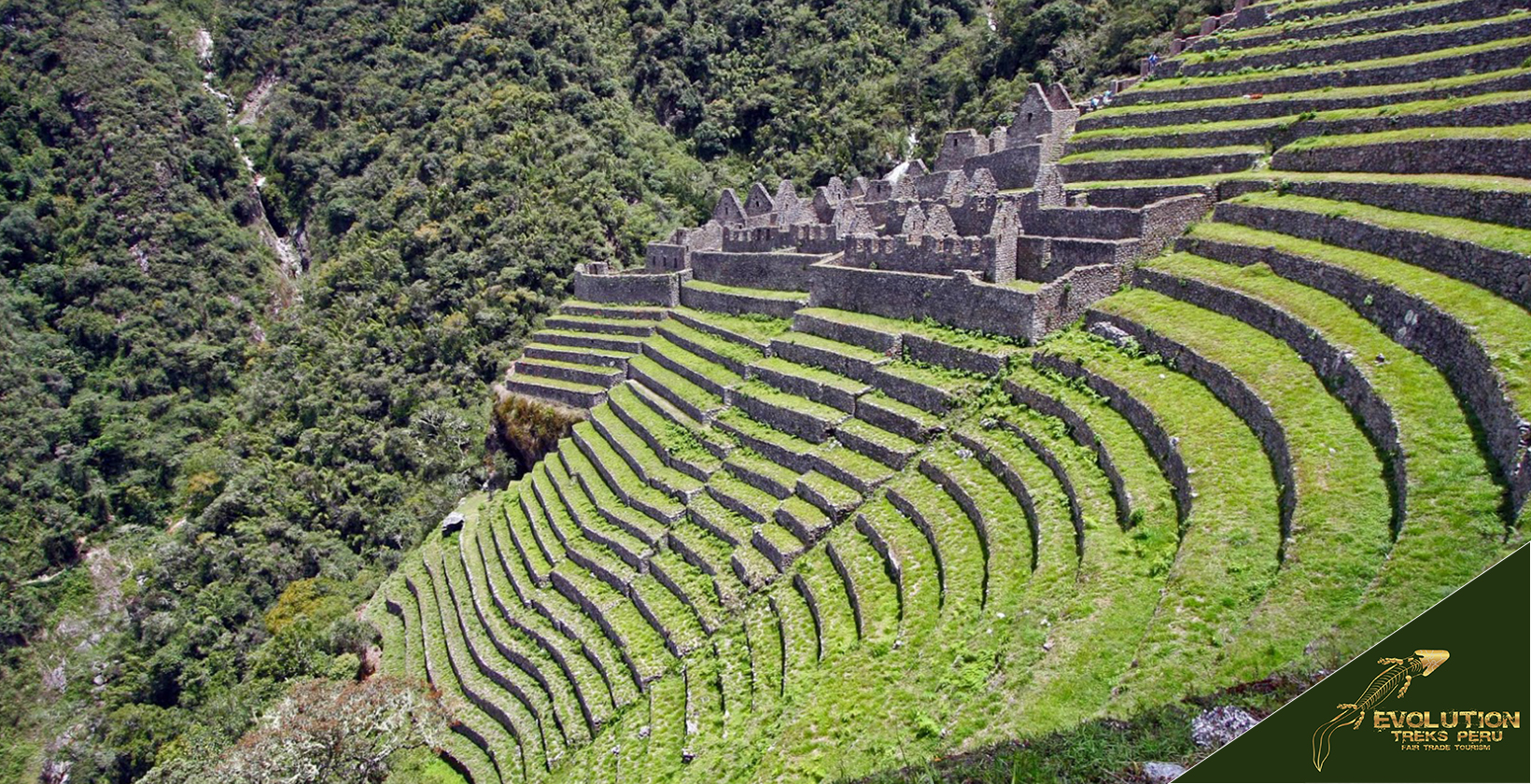
What to know before going Wiñay Wayna?
Before visiting Wiñay Wayna, there are several essential factors for visitors to consider to enhance their trip and ensure a stress-free experience. Here are some key points to keep in mind:
- Firstly permits are necessary for those who wish to hike the Inca Trail to Wiñay Wayna. These permits must be acquired in advance and can be limited in availability. Particularly during the high season, they tend to sell out quickly. It is therefore advised that visitors book their permits well ahead of time.
- Secondly, it is crucial to know the altitude at which Wiñay Wayna is situated. Standing at around 8,921 feet (2,720 meters) above sea level. It can pose a challenge for some individuals. Allowing sufficient time for acclimatization before embarking on the hike is important. As is staying hydrated by consuming an ample amount of water.
- Moreover. It is worth noting that the weather conditions in the Andes Mountains can be quite unpredictable, even during the dry season. Visitors must prepare themselves for sudden changes in weather patterns and temperatures. It is advisable to pack warm and waterproof clothing accordingly.
- Additionally.When packing for this adventure. Traveling light and bringing only necessary items for the hike is essential. Essential items include sturdy hiking boots, a daypack, sunscreen protection, a hat to shield from sun exposure, insect repellent, and any required medications. Furthermore, licensed guides must accompany hikers intending to take on the Inca Trail. Making arrangements beforehand ensures smoother hiking experiences coupled with enriched knowledge and enjoyment.
- Regarding crowds, it should be noted that Wiñay Wayna and the Inca Trail can become quite crowded during peak seasons. Visitors should prepare for larger crowds and plan their visit accordingly by avoiding peak times.
Overall. Wiñay Wayna stands as an awe-inspiring destination that offers a glimpse into the rich cultural heritage of the Inca civilization. However, with thorough planning and appropriate preparations, visitors can maximize their trip and fully admire all the wonders this remarkable site offers.
How is the Wiñay Wayna Itinerary?
Here’s a suggested itinerary for visiting Wiñay Wayna as part of a trip to Machu Picchu:
Day 1: Arrival in Cusco
- Arrive in Cusco and spend the day acclimating to the altitude.
- Take a walking tour of the historic city center and explore the local markets and restaurants.
- Overnight in Cusco.
Day 2: Inca Trail hike
- Depart early in the morning for the start of the Inca Trail hike.
- Hike approximately 7 miles (12 kilometers) to Wiñay Wayna, passing through several other Inca ruins along the way.
- Explore the ruins at Wiñay Wayna and learn about the history and significance of the site.
- Overnight at the Wiñay Wayna Campsite.
Day 3: Machu Picchu
- Continue the Inca Trail hike to Machu Picchu, passing through the Inti Punku (Sun Gate) and getting the first glimpse of Machu Picchu.
- Explore Machu Picchu with a guided tour, learning about the history and significance of the site.
- Take the bus or hike back to Aguas Calientes and overnight there.
Day 4: Return to Cusco
- Take the train or bus back to Cusco and spend the day exploring the city or taking a day trip to nearby sites such as the Sacred Valley or Maras and Moray.
- Overnight in Cusco.
Day 5: Departure
- Depart Cusco for Lima or your next destination.
It’s important to note that this itinerary is just a suggestion and can be customized based on personal preferences and travel plans. Visitors who prefer not to hike the Inca Trail can still visit Wiñay Wayna as part of a day trip from Aguas Calientes or Machu Picchu. Visitors should also be aware of the need for permits to hike the Inca Trail and should book well in advance.
How much does it cost to visit Wiñay Wayna?
The cost of visiting Wiñay Wayna can differ based on various factors such as the type of tour, the time of year, and the level of tour operator one hires to hike the Inca Trail or the Short Inca Trail. To give you an estimate, here are some approximate costs for visiting Wiñay Wayna:
The cost for an Inca Trail tour can vary depending on the time of year and the number of days on the trail. Typically it ranges from 500 to $1400 per person. These tours are necessary for hiking the Inca Trail, including the section that passes through Wiñay Wayna.
What is the best vehicle for visiting Wiñay Wayna?
Visitors can reach Wiñay Wayna on a guided hiking tour along the Inca Trail to MAchu Pichu. There are no roads for cars or other means of transportation to Winay Wayna, as it is located on the Inca Trail to Machu Picchu.
How many hours should a person spend in Wiñay Wayna?
The time a person should spend in Wiñay Wayna can vary depending on personal preferences and travel plans, but most visitors typically spend between 1 and 2 hours exploring the site.
Some visitors camping at Winay Wayna while taking a guided tour of the Inca Trail to Machu Picchu typically spend a set amount of time in Wiñay Wayna as part of their itinerary.
What is the nearest city to Wiñay Wayna?
Located near Wiñay Wayna is the enchanting town of Aguas Calientes itself- serving as an ideal base for all those seeking exploration of Wiñay Wayna and other mesmerizingInca ruins like Machu Picchu. Travelers departing from Aguas Calientes can make their way to these magnificent sites via two possible routes: enjoying a convenient bus journey or indulging in an adventurous hike along the renowned Inca Trail. From another perspective.
Cusco stands regal with its historical significance through its remarkable Incan and Spanish colonial landmarks. Moreover. This enthralling city boasts of a vibrant cultural scene accompanied by many options for dining, shopping, and accommodations.
How is the Past of Wiñay Wayna presented to the visitors?
Wiñay Waynas’ past is unveiled to visitors through personalized guided tours. For those seeking more comprehensive knowledge about Wiñay Wayna, guided tours led by professional guides are an enriching opportunity. These well-versed professionals expound upon significant facets of these ancient ruins while shedding light on old engineering feats the Inca civilization accomplished during construction.
Additionally. Visitors may access interpretive materials such as brochures or maps, supplementing their understanding of Wiñay Waynas’ profound implications. Whether these materials are acquired on-site or through tour operators and travel agencies, they extend the overall experience by offering additional insights. In sum.
How is the Preservation of Wiñay Wayna?
Wiñay Wayna, a protected archaeological site. It is of utmost importance to the Peruvian government and international organizations to prioritize its preservation. Several approaches are being employed to ensure the conservation of Wiñay Wayna:
Firstly. The National Institute of Culture (INC) manages Wiñay Wayna and oversees the site and its preservation. To minimize the impact of tourism on the site. The INC has implemented rules and regulations, including camping and littering restrictions. Secondly. Efforts are being made by both the INC and other organizations to actively conserve the ruins of Wiñay Wayna and protect them from natural and human threats. These endeavors involve stabilizing and repairing structures guarding against erosion and weathering and closely monitoring signs of damage. Additionally, archaeological research is continuously conducted at Wiñay Wayna.
This ongoing research has led to discoveries and insights about the site’s significance. Moreover. This knowledge informs preservation efforts undertaken to safeguard Wiñay Wayna for future generations.
Moreover. The INC and other organizations are carrying out educational initiatives to raise awareness among visitors and local communities about preserving Wiñay Wayna and other archaeological sites. Through educational programs and outreach endeavors. Individuals become aware of the site’s significance and responsibility for promoting sustainable tourism practices. Overall preserving Wiñay Wayna requires collaboration among multiple stakeholders who dedicate themselves to protecting this priceless heritage for future generations. Visitors can also contribute by adhering to rules while visiting the site, minimizing their impact on it, and supporting conservation and education endeavors.
Is Wiñay Wayna in UNESCO World Heritage Sites?
Wiñay Wayna is not included in the UNESCO World Heritage Site. However, Machu Picchu, where Winay Wayna belongs, is a UNESCO World Heritage Site. This designation was granted in 1983 and included the archaeological complex of Machu Picchu and the surrounding landscape, which provides numerous Inca ruins and other cultural and natural features. The Historic Sanctuary of Machu Picchu is considered one of the world’s most significant cultural and natural sites. It is a major tourist destination, attracting millions of visitors each year. The UNESCO designation recognizes the site’s historical, cultural, and natural significance and highlights the need for its protection and preservation for future generations.
Is Wiñay Wayna in danger?
Efforts are underway to protect and preserve Wiñay Wayna, like any archaeological site, from damage or degradation. Several potential threats exist, but measures are being taken to mitigate them. One such threat is tourism, a significant industry in the surrounding area. To reduce the risk, the Peruvian government has implemented measures to limit daily visitors and restrict access to certain site areas. Environmental factors also pose a risk, such as erosion and landslides. Conservation efforts include stabilizing walls and terraces. Repairing drainage systems. And safeguarding the ecosystem nearby. The increased development in the surrounding area is another concern, as it can impact the cultural and natural heritage of Wiñay Wayna.
Local communities actively manage the ecosystem to ensure it remains protected from harmful activities. Despite these potential threats, concerted efforts by the Peruvian government and local communities aim to preserve Wiñay Wayna as a valuable cultural and natural heritage site for future generations.
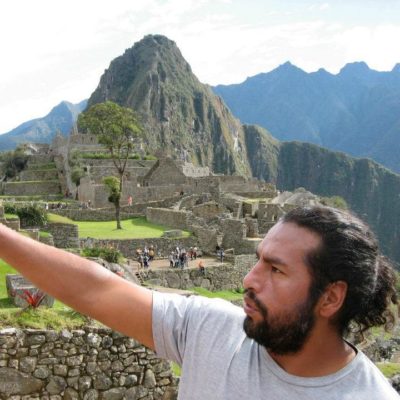
Miguel is a professional tour guide from Cusco, Peru, with almost 20 years of experience leading tours and a deep knowledge of Peru’s cultural and ecological diversity. He is also an advocate of ecotourism and cultural sensitivity and has lectured on these topics in the US and Europe. He co-founded Evolution Treks Peru, a worker-owned travel company based in Cusco.
